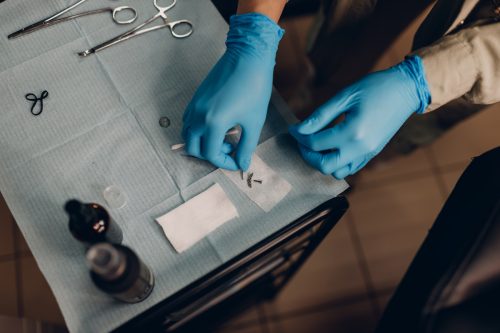The Medusa Piercing: What It Means and What to Expect
They're super trendy, but you'll want to do your research first.
Nothing is more thrilling than the prospect of getting a new piercing. But before you head to the piercing studio, it's important to do your research on the piercing you're interested in and the healing time associated with it—and that's especially true for facial piercings, whether it's on the eyebrow, nose, septum, or cheek. Nowadays, one coveted piercing is the Medusa piercing—and that's true for these, too. Keep reading for everything you need to know about this piercing, from how it got its name to how much it costs to what you can expect after getting it done.
RELATED: Should I Get a Daith Piercing?
What Is a Medusa Piercing?
A Medusa piercing is a type of body piercing that is placed on the philtrum, which is the anatomical term for the area above the cupid's bow on your upper lip. (The piercing is also called a philtrum piercing for exactly that reason.)
Some consider the Medusa a cousin of the vertical labret piercing, which goes underneath the lip, and the Monroe and Madonna piercings, which go on the right and left sides of the upper lip, respectively.
Medusa piercings first gained traction in the aughts, but according to Google Trends, they didn't reach peak popularity until 2022. The piercing is popular in the punk subculture and isn't seen on many mainstream celebs. However, Halsey may have given them a bump in popularity in March of 2023 after sporting a faux Medusa piercing at Paris Fashion Week.
Why Do They Call it a Medusa Piercing?
In Greek mythology, Medusa is a protective goddess known for her hair of snakes and her ability to turn the people she looks at into stone.
"She is an apotropaic symbol used to protect from and ward off the negative, much like the modern evil eye," writes The Metropolitan Museum of Art. "She represents a dangerous threat meant to deter other dangerous threats, an image of evil to repel evil."
Not much is known about why the Medusa piercing was named after such a character, but many hypothesize it's because the oral piercing looks as striking as Medusa is described to be. But hey, if it might have some extra protective powers, we won't complain.
How Much Do Medusa Piercings Cost?
The price of your Medusa piercing will depend on a lot of factors, like which city you're in, which studio you choose, and what type of jewelry you select for it.
"The typical price for a Medusa piercing before the price of the jewelry is added is $45 at Banter by Piercing Pagoda," says Ashley Sharp, senior director of piercing and innovation at Banter by Piercing Pagoda.
Your philtrum piercing is in a sensitive area that sees a lot of movement and activity such as eating and brushing your teeth. So, you'll want to select a high-quality piece of jewelry to put into it—and Sharp suggests implant-grade titanium or gold that's 14K or higher.
"Implant-grade titanium jewelry is rigid and less likely to get damaged and is also hypoallergenic and supports the healing process," she says. "Gold jewelry that is 14k or higher is also a good option for philtrum piercings as the high-quality metal supports healing while elevating style."
Of the two, the titanium will likely be more budget-friendly, but you can probably find options in either metal for under $75.
Does Getting a Medusa Piercing Hurt?
This one totally depends on your pain tolerance!
"Everyone experiences discomfort differently," explains Sharp. "Philtrum piercings, like all piercings, come with some level of discomfort—and if on a discomfort scale of one to 10, would fall right around a five."
Of course, the initial burst of pain is typically over within seconds, or, at the most, minutes, and you're left with your cool new piercing forever.
How Long Does it Take a Medusa Lip Piercing to Heal?
Part of committing to a new piercing is committing to the healing process, too. For a philtrum piercing, Sharp says that should take between three and four months, although you'll always want to err on the side of caution.
So, what does that mean? Keep reading…
RELATED: How to Rock a "Wolf Cut," the Trendiest Hairstyle Celebs Love.
Medusa Piercing Aftercare Rules

Throughout the healing process, you'll want to be on your best post-piercing behavior. That means keeping your piercing clean and avoiding certain actions so your piercing heals quickly and without issues.
Watch What You Eat
Since the philtrum piercing is on your lip, the things you eat can impact it. "We recommend avoiding highly acidic, spicy, or salty foods for the first week after receiving a philtrum piercing," says Sharp. "During your healing process, rinse your mouth with clean water after eating any food."
Don't Play With it Too Much
It's always tempting to touch a new piercing. But keeping your fingers otherwise occupied will help in the long run, as hands carry tons of infectious microorganisms. "Every time you touch a fresh piercing, you introduce those pathogens to it," says Sharp.
Keep it Clean
Like many piercings, you'll want to use an alcohol-free mouthwash or store-bought sterile saline solution, like H2Ocean. Mixing your own saline solution at home is unsafe and won't meet the same standards of sterility.
Avoid Using Make-Up Around the Area
If you're always testing out a new lipstick—or dabbing highlighter onto your cupid's bow—this one might be tough.
"Until the piercing is fully healed, it is advised to avoid applying makeup or skincare products directly to the area," says Sharp. Again, the risk of introducing infectious pathogens is just too high.
Keep it Dry
To keep your Medusa piercing clean, use paper towels, as cloth can sometimes snag on your new jewelry. Also, avoid going underwater in pools and hot tubs. The water could expose the piercing site to yucky bacteria.
How to Change Your Philtrum Piercing

You'll want to ensure your piercing is fully healed before you change it—so, likely three to four months, per Sharp. You can also pop by your piercing studio if you're unsure. Here's how to go about swapping your jewelry:
- Gently remove existing jewelry: The piece will likely be a stud. First, wash your hands. Then, unscrew it from the back and remove it from the front.
- Unscrew the threaded back of the new jewelry: It should have a similar mechanism as the piece you just removed.
- Gently insert the prong into the piercing hole. You'll want to be as still as possible when you do this, and keep the screw at the ready. Flip your lip upside down, and push the prong in from the back.
- Screw in the top of the prong. The ball should screw on from the front. If it pinches or hurts, you've screwed it too tight.
What Kind of Jewelry Can I Use for My Medusa Piercing?
- Labret Stud: These look like a traditional stud with a flat plate in the back, and they're the most popular of the Medusa jewelry. You push the prong through your lip from the back, and you screw the stud on from the front.
- Diamond Stud: Some labret posts are topped with a diamond on the front if you're feeling extra fancy!
Will a Medusa Piercing Leave a Scar?
Unfortunately, yes, if you decide to remove your Medusa piercing, it's likely a permanent hole or scar will remain. Keep that in mind before making your appointment.
Possible Medusa Piercing Side Effects
- Piercing Rejection: Piercings aren't natural, and sometimes the body decides this foreign object, no matter how stylish, simply shouldn't be there. "A rejection is when inflammation, which always occurs with piercings, starts to move the piercing toward the skin surface and can even cause it to perforate out of the skin," Angelo Landriscina, MD, board-certified dermatologist and site director for dermatology at Mount Sinai Doctors-Brooklyn Heights in New York, told Health. In this case, you'd want to remove the piercing immediately.
- Piercing Bumps: Percing bumps are caused by similar inflammation. They're quite common, and you'll want to move forward with your healing protocol per usual.
- Piercing Infection: You'll know your piercing is infected if the area around it is swollen, hot, red, and painful. If the symptoms persist, see a healthcare provider, according to the Cleveland Clinic.
Conclusion
Before committing to the piercing process, you'll want to carefully consider both the look of the jewelry and the time it takes to heal. Ensure both fit with your lifestyle and expectations before moving forward. For more style and accessories advice, visit Best Life again soon.






















